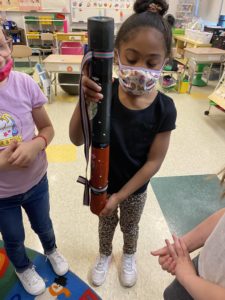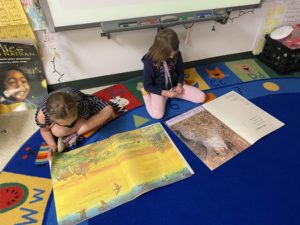
Christie Graves
We’re honored to spotlight New York educator Christie Graves, who serves as the Assistant Principal at North Rose-Wolcott Elementary School in North Rose, New York.
In this interview with Dr. Katy Cortelyou, Christie shares her insights and experiences implementing the Collaborative Literacy ELA suite and SIPPS.
Tell us a little about yourself, North Rose-Wolcott Elementary, and the students you serve.
My name is Christie Graves. I am currently the Assistant Principal at North Rose-Wolcott Elementary in North Rose, New York. We are a rural school district located in upstate New York in the center of “apple country.” Our district is the combination of a handful of small rural towns located on the shores of Lake Ontario.
The students in our building range from grades UPK–4 (however we have also had our 5th and 6th graders in our building for the last couple of years as the middle school gets renovated). We have the full range of the “elementary years” under one roof!
What is the most rewarding part of being an educator for you?
Education has always been an extremely rewarding profession for me. The most rewarding part always centers around the magic that happens when a student learns to read.
From my first years as a first-grade teacher, to later years as a literacy specialist and instructional coach, to my current position as an administrator, literacy instruction has continually found its way into my role. I strongly believe that every student can become a reader and every teacher deserves to have quality resources at their fingertips that make the journey of literacy possible!
How did your district become interested in Collaborative Literacy?
When I was hired as the assistant principal at North Rose-Wolcott, the district had recently begun the process of exploring their current reading practices and considering the adoption of a new reading program.
I asked our Assistant Superintendent of Instruction if I could come alongside the staff and administrators who were engaged in this work in order to get a better understanding of where the district was and where we were hoping to be. This process led us to Collaborative Classroom, and the team felt it was a perfect fit for our K–6 students and teachers.
How long has your district been implementing Collaborative Literacy? Tell us a little about the implementation.

Provided with district permission
We are currently in our first year of Collaborative Literacy implementation. The work around implementation began prior to this school year as we were given the opportunity to develop a variety of professional learning sessions for our teachers and staff.
Together with my two instructional coaches, we created virtual live lessons, asynchronous playlists, and question-and-answer sessions in the hopes of building teacher capacity and buy-in. As soon as the materials were delivered, we found a way to get the resources into our teachers hands.
We continued our work over the summer meeting with grade level teams to start to formulate schedules and continue to build understanding around each of the literacy components. We used the learning portal extensively and encouraged our teachers to watch videos, complete the learning modules, and read the articles about implementation.
At the same time, the instructional coach team began digging deeper into lesson structure, procedures and protocols, and SIPPS (we had begun using SIPPS the previous year in reading intervention).
Once the year began, we started working with our wonderful Collaborative Classroom trainer, Kristi Bacus, about where our staff was in the process, what pieces they needed more learning around, and what feedback we were getting. Admin walk-throughs were used to get a better sense of strength areas as well as areas of need. Instructional coaches continued to meet with grade-level teams weekly to discuss questions or concerns.
What do you appreciate about Collaborative Literacy? What do teachers appreciate about it?

Provided with district permission
There is so much I appreciate about Collaborative Literacy, it is hard to narrow it down to a few things. The literature is AMAZING. From Making Meaning to Being a Writer to Being a Reader, the texts are age-appropriate and picked specifically for the instructional outcomes of the lessons.
The discussion protocols are engaging and encourage higher-order thinking, even for our youngest students. They focus on the social-emotional learning skills that students need to be active members of our community.
I am also amazed at how well the Being a Reader procedures and protocols work on even our most reluctant readers. I am thrilled to see the way students progress through the sets and are able to apply their newly learned skills in their independent reading books.
Teachers appreciate the engaging lessons, the amazing literature, and the way their students have begun to love reading and writing again!
What have you noticed about students’ learning and engagement? What have teachers noticed?
I have noticed increased levels of student engagement at every grade. Students enjoy the texts, ask lots of questions, and consistently engage in the discussion protocols. Quite a few teachers have mentioned that the Making Meaning Vocabulary and Being a Writer lessons have quickly become student favorites.
“Our winter benchmark data was overwhelmingly positive (even in the middle of a pandemic). Student growth was observed in every grade level, and in every classroom, especially in the areas of oral reading fluency and vocabulary.”
Our winter benchmark data was overwhelmingly positive (even in the middle of a pandemic). Student growth was observed in every grade level, and in every classroom, especially in the areas of oral reading fluency and vocabulary. The classroom and student assessment pieces give teachers a good way to monitor student growth between benchmark assessments. We have coupled that along with our building-wide progress monitoring system to give teachers and interventionists a consistent measure of student application of targeted skills.
How has Collaborative Literacy shifted teaching practices and/or professional learning at North Rose-Wolcott Elementary?
The biggest shift in teacher practice Collaborative Literacy has brought to our school would be the building-wide focus on systematic phonics instruction. The set progression in Being a Reader coupled with the SIPPS instruction during Tier 2 intervention time has created a dynamic momentum within our building. It is evident how impactful it is for our students to have Tier 1, 2, and 3 instructional components that complement each other and work together to get maximum benefit!
“The biggest shift in teacher practice Collaborative Literacy has brought to our school would be the building-wide focus on systematic phonics instruction. The set progression in Being a Reader coupled with the SIPPS instruction during Tier 2 intervention time has created a dynamic momentum within our building.”
Our special education teachers were also trained in using SIPPS, which has led to increased maximizing of instruction and an additional layer of reading development for our special education students.
What thoughts or insights would you share with a district that is considering Collaborative Literacy?
I would encourage any district who is considering Collaborative Literacy to consider how to build capacity with a team of teachers, instructional coaches and/or administrators prior to implementation. I would encourage that team to begin to think about professional learning experiences for the teachers before the expected implementation date. Give teachers time to become familiar with the materials, learn about procedures and protocols, develop their schedule, and learn how to use the manuals effectively.
I would consider digging deeper into the assessments (since portfolio-based assessments can be a shift for some educators) and help teachers to have a solid understanding of IDR (Individualized Daily Reading). This component is a crucial part of the Making Meaning portion of the program and needs to be an area of focus (especially during early months of implementation). The power of building stamina and conferencing with readers on a regular basis needs to become an integral part of daily reading instruction. It is so powerful if/when done with instructional intentionality. Just wait and see!
